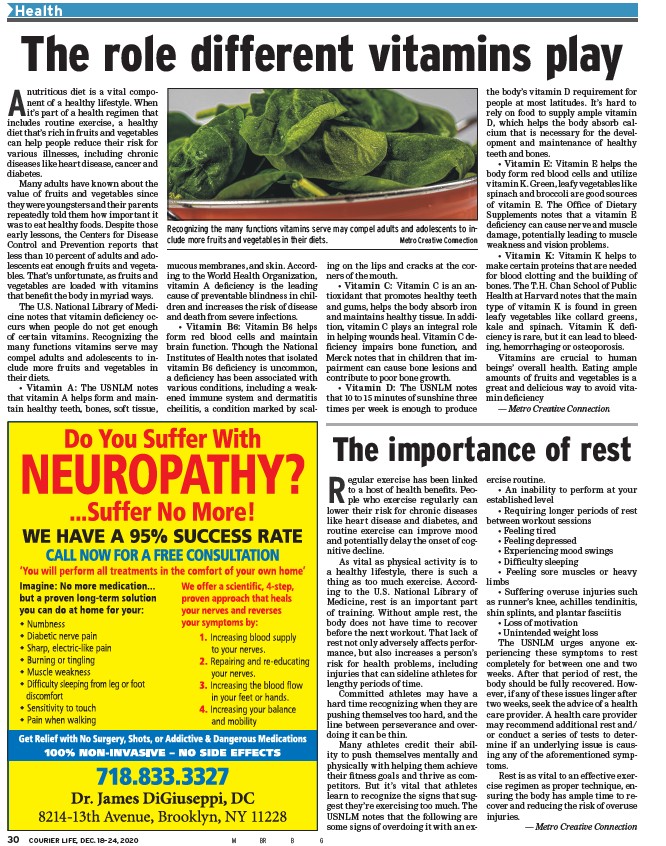
The role different vitamins play
A nutritious diet is a vital component
of a healthy lifestyle. When
it’s part of a health regimen that
includes routine exercise, a healthy
diet that’s rich in fruits and vegetables
can help people reduce their risk for
various illnesses, including chronic
diseases like heart disease, cancer and
diabetes.
Many adults have known about the
value of fruits and vegetables since
they were youngsters and their parents
repeatedly told them how important it
was to eat healthy foods. Despite those
early lessons, the Centers for Disease
Control and Prevention reports that
less than 10 percent of adults and adolescents
eat enough fruits and vegetables.
That’s unfortunate, as fruits and
vegetables are loaded with vitamins
that benefi t the body in myriad ways.
The U.S. National Library of Medicine
notes that vitamin defi ciency occurs
when people do not get enough
of certain vitamins. Recognizing the
many functions vitamins serve may
compel adults and adolescents to include
more fruits and vegetables in
their diets.
• Vitamin A: The USNLM notes
that vitamin A helps form and maintain
healthy teeth, bones, soft tissue,
mucous membranes, and skin. According
to the World Health Organization,
vitamin A defi ciency is the leading
cause of preventable blindness in children
and increases the risk of disease
and death from severe infections.
• Vitamin B6: Vitamin B6 helps
form red blood cells and maintain
brain function. Though the National
Institutes of Health notes that isolated
vitamin B6 defi ciency is uncommon,
a defi ciency has been associated with
various conditions, including a weakened
immune system and dermatitis
cheilitis, a condition marked by scaling
COURIER L 30 IFE, DEC. 18–24, 2020 M BR B G
on the lips and cracks at the corners
of the mouth.
• Vitamin C: Vitamin C is an antioxidant
that promotes healthy teeth
and gums, helps the body absorb iron
and maintains healthy tissue. In addition,
vitamin C plays an integral role
in helping wounds heal. Vitamin C defi
ciency impairs bone function, and
Merck notes that in children that impairment
can cause bone lesions and
contribute to poor bone growth.
• Vitamin D: The USNLM notes
that 10 to 15 minutes of sunshine three
times per week is enough to produce
the body’s vitamin D requirement for
people at most latitudes. It’s hard to
rely on food to supply ample vitamin
D, which helps the body absorb calcium
that is necessary for the development
and maintenance of healthy
teeth and bones.
• Vitamin E: Vitamin E helps the
body form red blood cells and utilize
vitamin K. Green, leafy vegetables like
spinach and broccoli are good sources
of vitamin E. The Offi ce of Dietary
Supplements notes that a vitamin E
defi ciency can cause nerve and muscle
damage, potentially leading to muscle
weakness and vision problems.
• Vitamin K: Vitamin K helps to
make certain proteins that are needed
for blood clotting and the building of
bones. The T.H. Chan School of Public
Health at Harvard notes that the main
type of vitamin K is found in green
leafy vegetables like collard greens,
kale and spinach. Vitamin K defi -
ciency is rare, but it can lead to bleeding,
hemorrhaging or osteoporosis.
Vitamins are crucial to human
beings’ overall health. Eating ample
amounts of fruits and vegetables is a
great and delicious way to avoid vitamin
defi ciency
— Metro Creative Connection
Regular exercise has been linked
to a host of health benefi ts. People
who exercise regularly can
lower their risk for chronic diseases
like heart disease and diabetes, and
routine exercise can improve mood
and potentially delay the onset of cognitive
decline.
As vital as physical activity is to
a healthy lifestyle, there is such a
thing as too much exercise. According
to the U.S. National Library of
Medicine, rest is an important part
of training. Without ample rest, the
body does not have time to recover
before the next workout. That lack of
rest not only adversely affects performance,
but also increases a person’s
risk for health problems, including
injuries that can sideline athletes for
lengthy periods of time.
Committed athletes may have a
hard time recognizing when they are
pushing themselves too hard, and the
line between perseverance and overdoing
it can be thin.
Many athletes credit their ability
to push themselves mentally and
physically with helping them achieve
their fi tness goals and thrive as competitors.
But it’s vital that athletes
learn to recognize the signs that suggest
they’re exercising too much. The
USNLM notes that the following are
some signs of overdoing it with an exercise
routine.
• An inability to perform at your
established level
• Requiring longer periods of rest
between workout sessions
• Feeling tired
• Feeling depressed
• Experiencing mood swings
• Diffi culty sleeping
• Feeling sore muscles or heavy
limbs
• Suffering overuse injuries such
as runner’s knee, achilles tendinitis,
shin splints, and plantar fasciitis
• Loss of motivation
• Unintended weight loss
The USNLM urges anyone experiencing
these symptoms to rest
completely for between one and two
weeks. After that period of rest, the
body should be fully recovered. However,
if any of these issues linger after
two weeks, seek the advice of a health
care provider. A health care provider
may recommend additional rest and/
or conduct a series of tests to determine
if an underlying issue is causing
any of the aforementioned symptoms.
Rest is as vital to an effective exercise
regimen as proper technique, ensuring
the body has ample time to recover
and reducing the risk of overuse
injuries.
— Metro Creative Connection
Recognizing the many functions vitamins serve may compel adults and adolescents to include
more fruits and vegetables in their diets. Metro Creative Connection
The importance of rest
Health